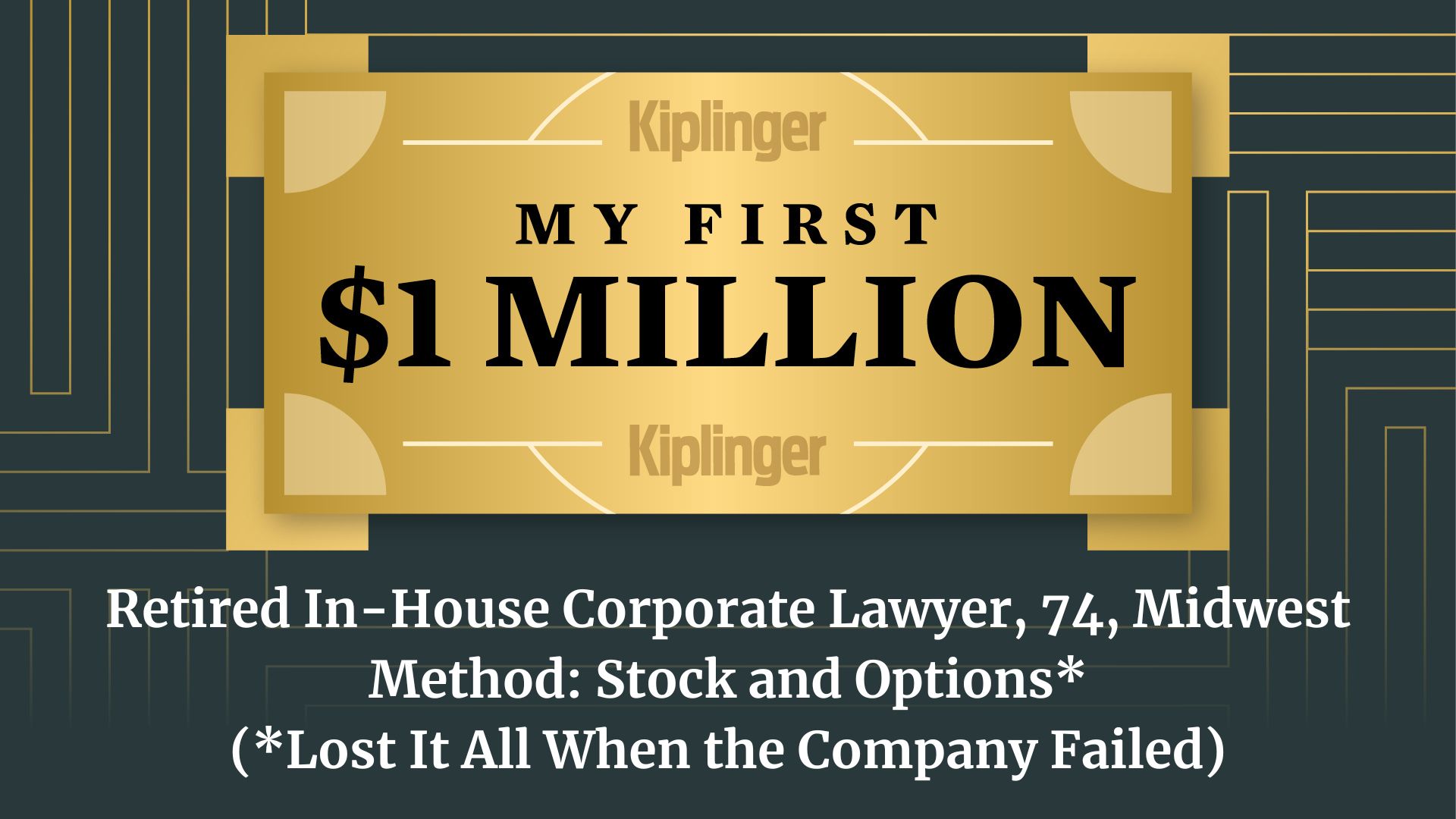Year-End Retirement Tax Planning Actions if You Have $1 Million or More
Consider implementing these four strategies before December 31 to potentially improve your tax situation for this year and the future.


There are two big deadlines every year when it comes to tax planning. The most important deadline is December 31, and the other is April 15 (the deadline to file your taxes).
Most of the strategies we’re talking about here will need to be done before December 31 because they involve tax planning, not tax prep.
What’s the difference? Tax planning is what you do throughout the year, while tax prep is how you collect and present your tax information to the IRS for the previous tax year.
From just $107.88 $24.99 for Kiplinger Personal Finance
Become a smarter, better informed investor. Subscribe from just $107.88 $24.99, plus get up to 4 Special Issues

Sign up for Kiplinger’s Free Newsletters
Profit and prosper with the best of expert advice on investing, taxes, retirement, personal finance and more - straight to your e-mail.
Profit and prosper with the best of expert advice - straight to your e-mail.
Both are important, but there are actions you can take before the end of the year to complete tax prep efficiently and make sure you’re taking advantage of opportunities to potentially reduce your tax bill.
About Adviser Intel
Kiplinger's Adviser Intel is a curated network of trusted financial professionals who share expert insights on wealth building and preservation. Contributors, including fiduciary financial planners, wealth managers, CEOs and attorneys, provide actionable advice about retirement planning, estate planning, tax strategies and more. Experts are invited to contribute and do not pay to be included, so you can trust their advice is honest and valuable.
Action No. 1: Consider a Roth conversion
One of the most important strategies we're seeing right now is a Roth conversion, mostly because tax rates are among historical lows. With the recent passing of the One Big Beautiful Bill (OBBB), this deal just got sweeter.
With a Roth conversion, you move money from your tax-deferred investments (e.g., 401(k) or traditional IRA) to a tax-free type of investment like a Roth.
The converted amount is counted as ordinary income and taxed at your regular income rates for the year in which you take the conversion, but you will not pay taxes on future distributions from a Roth.
This strategy doesn't make sense for everyone, but we often see this work well for those who have $1 million or more saved in tax-deferred investments (we call them Midwestern Millionaires) or those with pensions (we call those with pensions and $1 million-plus saved a part of The 2% Club).
This is because of required minimum distributions (RMDs), which the IRS says you must take beginning at age 73 or 75 (depending on the year you're born).
With RMDs, the government says you must take a certain amount from your 401(k) or IRA each year, and this distribution is counted toward your taxable income.
The more money you have saved in a tax-deferred account, the more you will be required to take out each year — and the more you could end up owing in taxes.
Converting a tax-deferred account to a Roth allows you to get ahead of this requirement. But the conversion must be completed by December 31, because custodians (the firms that hold your money) may require longer processing times due to a higher volume of requests.
If you’re working with an adviser, they can run in-depth calculations to determine whether a Roth conversion works for your situation.
They can also help you decide how much of your tax-deferred accounts to convert for that tax year. Since a Roth conversion can also impact capital gains and Medicare IRMAA premiums, it’s best to work with a knowledgeable and experienced tax planning team.
Action No. 2: Donate to charity
Another tax planning strategy to complete before the end of the year is to donate to charitable organizations. If you’re age 70½ or older and own an IRA, a qualified charitable distribution (QCD) might be a good option for reducing your taxes while doing good for your community.
A QCD allows you to move money from your IRA directly to a charity of your choosing. This donation is a win-win: Not only does it reduce your taxable income for the year, but the charity is not taxed for the donation.
People who are younger than 70½ may want to look into a donor-advised fund (DAF). Through a DAF, you can bunch charitable donations for one year or multiple years, then donate the assets to your chosen charity.
The primary reason for this strategy is to take advantage of itemized deductions vs the standard deduction, which can lead to more tax savings.
The other advantage is the ability to move highly appreciated non-qualified assets directly into the DAF; when you sell the asset in the DAF, you will avoid paying capital gains tax on that asset.
Action No. 3: Fund your retirement plan
If you’re still working, then it’s a good idea to continue saving money into your Roth or employer-sponsored plan (e.g., 401(k), 403(b) or Thrift Savings Plan).
Be aware that these funds are coming straight from your paycheck, so it’s a good idea to check your contributions to make sure you’re taking full advantage of an employer match.
Looking for expert tips to grow and preserve your wealth? Sign up for Adviser Intel, our free, twice-weekly newsletter.
We’re seeing many people with $1 million or more saved opt into the Roth 401(k) if their employer plan offers it. Under this option, your funds grow tax-free, balancing out funds saved in traditional tax-deferred plans.
People who are age 50 or older can defer $23,500 to their employer-sponsored plan, plus make an additional catch-up contribution of $7,500 for a total deferral of $30,500 for the 2025 tax year. If they are age 60 to 63, the catch-up contribution is $11,250.
Action No. 4: Contribute to an IRA
The final tax planning strategy I’ll mention actually doesn’t have to happen until April 15, and you must have earned income to take advantage of it.
If your income comes in higher than expected or more of your Social Security benefits were taxable, you can contribute to a traditional IRA to lower your taxable income for the tax year in which the contribution is made.
If you want to be in a lower tax bracket in the future, you might consider contributing to a Roth IRA instead and take advantage of tax-free growth.
All of these strategies can be effective, but they’re useless unless you act.
Take these steps now for the most impact on your retirement planning. It’s also a good idea to make sure your financial planner and accountant are working together to ensure you’re getting the most out of your plan.
It can be useful to work with a financial planning team that offers these services under one roof to ensure nothing is missed and communication is on point.
Related Content
- You’re 62 Years Old With $1 Million Saved: Can You Retire?
- Do You Have at Least $1 Million in Tax-Deferred Investments?
- Should You Move Your 401(k) to an IRA Once You Hit 59½?
- Here's Why You Shouldn't Put All Your Money Into Roth IRAs
- Do You Have the Five Pillars of Retirement Planning in Place?
Profit and prosper with the best of Kiplinger's advice on investing, taxes, retirement, personal finance and much more. Delivered daily. Enter your email in the box and click Sign Me Up.

Joe F. Schmitz Jr., CFP®, ChFC®, CKA®, is the founder and CEO of Peak Retirement Planning, Inc., which was named the No. 1 fastest-growing private company in Columbus, Ohio, by Inc. 5000 in 2025. His firm focuses on serving those in the 2% Club by providing the 5 Pillars of Pension Planning. Known as a thought leader in the industry, he is featured in TV news segments and has written three bestselling books: I Hate Taxes (request a free copy), Midwestern Millionaire (request a free copy) and The 2% Club (request a free copy).
Investment Advisory Services and Insurance Services are offered through Peak Retirement Planning, Inc., a Securities and Exchange Commission registered investment adviser able to conduct advisory services where it is registered, exempt or excluded from registration.
-
 I'm want to give my 3 grandkids $5K each for Christmas.
I'm want to give my 3 grandkids $5K each for Christmas.You're comfortably retired and want to give your grandkids a big Christmas check, but their parents are worried they might spend it all. We ask the pros for help.
-
 If You're Not Doing Roth Conversions, You Need to Read This
If You're Not Doing Roth Conversions, You Need to Read ThisRoth conversions and other Roth strategies can be complex, but don't dismiss these tax planning tools outright. They could really work for you and your heirs.
-
 Could Traditional Retirement Expectations Be Killing Us?
Could Traditional Retirement Expectations Be Killing Us?A retirement psychologist makes the case: A fulfilling retirement begins with a blueprint for living, rather than simply the accumulation of a large nest egg.
-
 I'm Retired and Want to Give My 3 Grandkids $5,000 Each for Christmas, But Their Parents Don't Want Them to Spend It All.
I'm Retired and Want to Give My 3 Grandkids $5,000 Each for Christmas, But Their Parents Don't Want Them to Spend It All.You're comfortably retired and want to give your grandkids a big Christmas check, but their parents are worried they might spend it all. We ask the pros for help.
-
 I'm a Financial Planner: If You're Not Doing Roth Conversions, You Need to Read This
I'm a Financial Planner: If You're Not Doing Roth Conversions, You Need to Read ThisRoth conversions and other Roth strategies can be complex, but don't dismiss these tax planning tools outright. They could really work for you and your heirs.
-
 Could Traditional Retirement Expectations Be Killing Us? A Retirement Psychologist Makes the Case
Could Traditional Retirement Expectations Be Killing Us? A Retirement Psychologist Makes the CaseA retirement psychologist makes the case: A fulfilling retirement begins with a blueprint for living, rather than simply the accumulation of a large nest egg.
-
 I'm a Financial Adviser: This Is How You Can Adapt to Social Security Uncertainty
I'm a Financial Adviser: This Is How You Can Adapt to Social Security UncertaintyRather than letting the unknowns make you anxious, focus on building a flexible income strategy that can adapt to possible future Social Security changes.
-
 The Stoic Retirement: Ancient Wisdom for Today’s Biggest Life Transition
The Stoic Retirement: Ancient Wisdom for Today’s Biggest Life TransitionA "Stoic retirement" doesn't mean depriving yourself. It's a character-based approach to life and aging that can bring calm and clarity.
-
 My Teen Crashed His Car and Now Our Insurance Has Tripled. What Now?
My Teen Crashed His Car and Now Our Insurance Has Tripled. What Now?Dealing with the costly aftermath of a teen car accident is stressful. Here are your options for navigating it.
-
 11 Outrageous Ways To Spend Money in Retirement
11 Outrageous Ways To Spend Money in RetirementWhether you have excess cash to spend or want to pretend, here’s a look at 11 ridiculous ways retirees can splurge.
-
 My First $1 Million: Retired In-House Corporate Lawyer, 74, Midwest
My First $1 Million: Retired In-House Corporate Lawyer, 74, MidwestEver wonder how someone who's made a million dollars or more did it? Kiplinger's My First $1 Million series uncovers the answers.